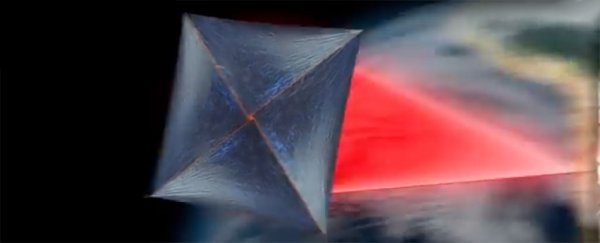It's one of the most ambitious scientific voyages humanity has ever envisaged, but researchers have discovered an obstacle that could jeopardise our best chances of exploring Alpha Centauri – home of the closest Earth-like planet candidate ever found.
Breakthrough Starshot is a US$100 million research effort designed to send a postage stamp-sized 'nano-spacecraft' – propelled by lasers from Earth – to our closest star system, Alpha Centauri. But scientists have found that the tiny spacecraft might not survive the epic journey.
Representing a completely new kind of space probe, the 'wafersat' nanocraft scientists want to send across the galaxy is essentially a very tiny solar sail, designed to be travel at speeds of up to 20 percent of the speed of light, after receiving an initial boost from ground-based lasers on Earth.
But given the craft is so tiny and light – it's essentially just a circuit board with a small sail attached - there are now fears that even small collisions with loose matter in space at such high speeds could pose a threat to the probe.
Researchers investigating the first of several hypothetical obstacles to the plan looked into what the effects would be of super-high-speed collisions with cosmic gas and dust floating in the void. While the damage the nanocraft would incur is significant, for smaller particles at least, the team remains hopeful.
"We did a thorough analysis, taking all the relevant physics into consideration," astronomer Avi Loeb, Breakthrough Starshot's chief scientist, told Jacob Aron at New Scientist. "We didn't see any showstoppers."
Calculating the effects of gas and dust bombardment on graphite and quartz – which together make up the majority of the nanocraft - the researchers found that dust collisions pose the greatest risk to the mission.
Collisions with heavy atoms in gas could hypothetically damage the surface of the nanocraft to a depth of approximately 0.1 mm, but interstellar dust – which could vary in size – would be more problematic.
Running into small dust grains means the nanocraft, which only weighs a few grams, could incur numerous craters on its surface, eroding the outer layer by up to around 0.5 mm, and potentially inducing melting effects due to the energy the craft receives from the impact.
"Erosion of solid surfaces will be a severe problem at these speeds," astrobiologist Ian Crawford from Birkbeck, University of London, who wasn't involved with the research, told New Scientist.
But collisions with larger dust grains would be catastrophic, the researchers think. If the nanocraft were to run into a grain just 15 micrometres wide – which is still thinner than a human hair – it would be game over for the spacecraft.
Fortunately, the odds of a collision with such a large dust grain in space are extremely low, with the researchers calculating the odds of being one in 1050.
And now that we know about the risks of impact with smaller gas and dust particles, the scientists say there are a number of things the team could do to mitigate the problem.
One approach could be to minimise the cross-sectional area of the craft to reduce the chance of collisions, or they could add a protective layer to the front of the wafer, so impacts with matter in space damage only the shield, and not the craft itself.
The researchers also think the solar sail needs to be capable of folding and retracting itself behind this shield, so it doesn't incur damage during the voyage.
While all these modifications will add to the weight of the craft, that's a small price to pay to safeguard the overall project – the costs of which are expected to ultimately run into the billions.
But that could be money well spent – especially since there's a chance the mission could give us our first opportunity to study our newly discovered neighbour: an Earth-like planet just 4.2 light-years away called Proxima b that scientists finally spilled the beans on this week.
The research hasn't been peer-reviewed by other scientists just yet, so we need to remember that when considering its findings. But it's also just the first of many studies designed to examine how feasible Breakthrough Starshot really is – so we can expect to see the science keep coming while researchers figure out how to pull this amazing star trek off.
And while there's bound to be many complications along the way, just like the risk of running into an interstellar dust grain, it pays to be prepared.
"I don't think it's going to be a show-stopper, it's just going to make things more complex," says astronautics researcher Paulo Lozano from MIT, who wasn't involved with the study. "It is pretty clear they are paying a lot of attention to the details, and that's good."
The findings can be viewed on arXiv.org.
